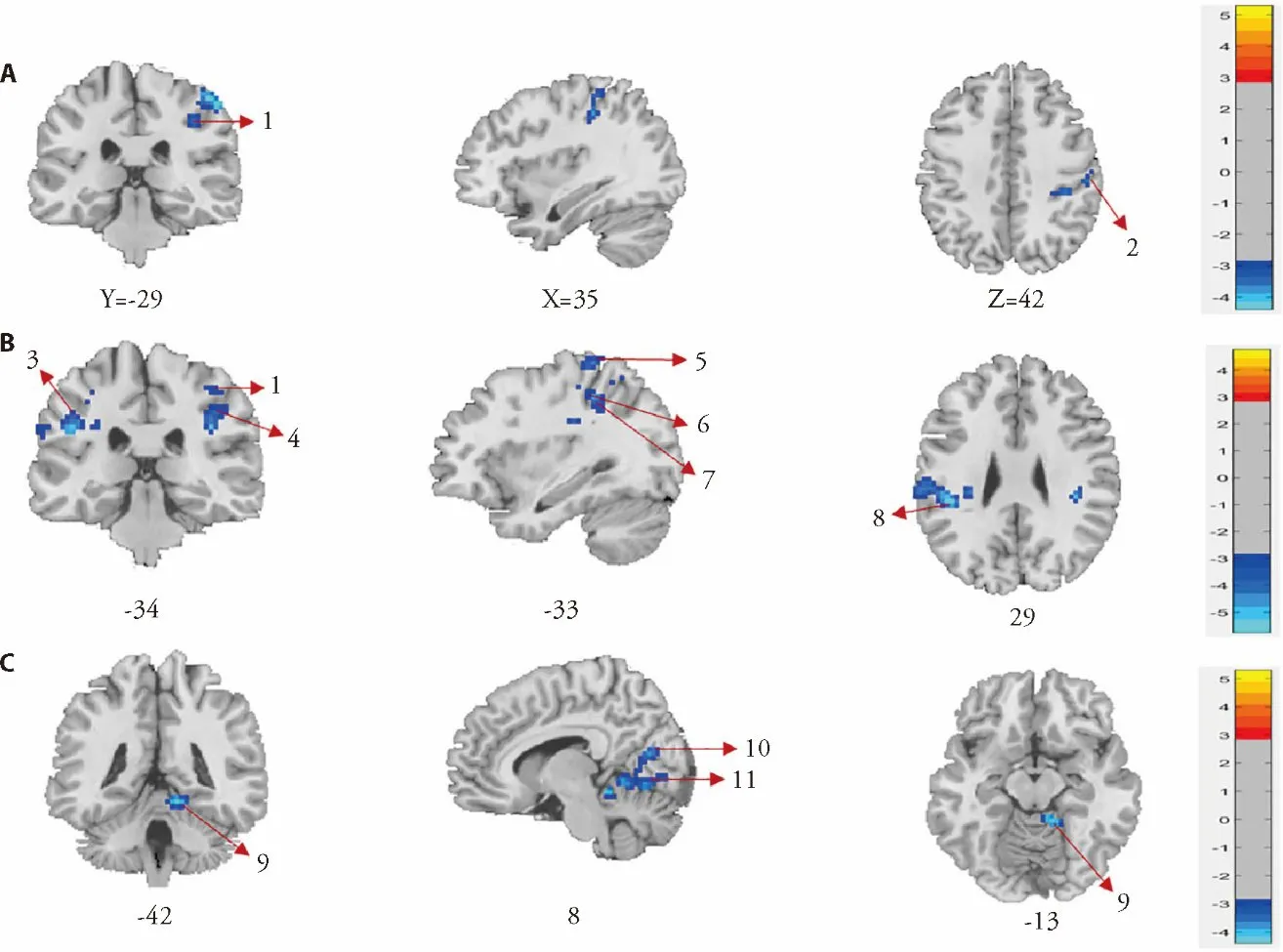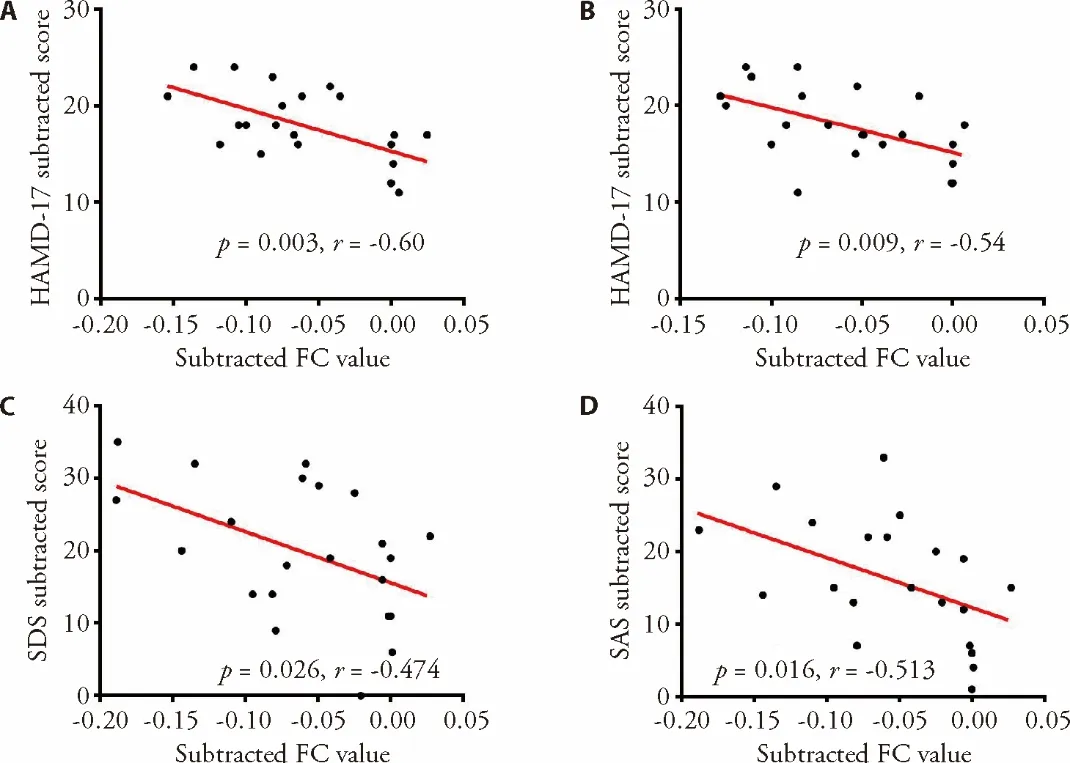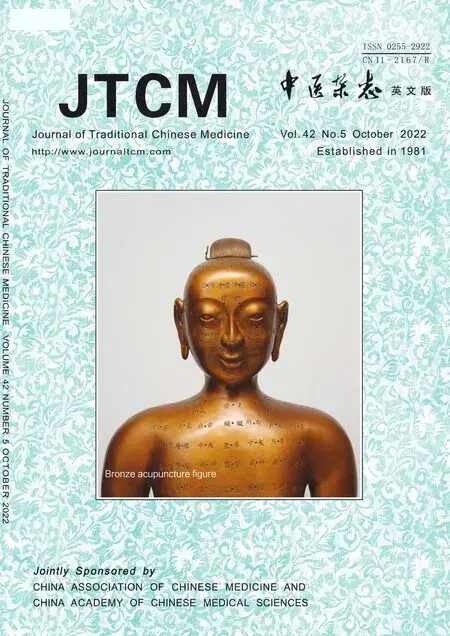Preliminary single-arm study of brain effects during transcutaneous auricular vagus nerve stimulation treatment of recurrent depression by resting-state functional magnetic resonance imaging
2022-10-14CHENLimeiSUNJifeiGUOChunleiLIXiaojiaoWANGZhiHongYangFANGJiliang
CHEN Limei,SUN Jifei,GUO Chunlei,LI Xiaojiao,WANG Zhi,Hong Yang,FANG Jiliang
CHEN Limei,SUN Jifei,GUO Chunlei,LI Xiaojiao,WANG Zhi,Hong Yang,FANG Jiliang,Radiology Department,Guang'anmen Hospital of China Academy of Chinese Medical Sciences,Beijing 10003,China
Abstract OBJECTIVE: To examine the brain effects of transcutaneous auricular vagus nerve stimulation (taVNS)treatment of recurrent depression based on the functional brain network by using resting-state functional magnetic resonance imaging (fMRI).METHODS: Twenty-five patients with recurrent depression were enrolled in a single-arm trial of taVNS treatment for eight weeks.Clinical results were assessed by 17-item Hamilton Depression Rating Scale (HAMD-17),Hamilton Anxiety Scale (HAMA),Self-Rating Depression Scale (SDS),Self-Rating Anxiety Scale (SAS),and Ruminative Response Scale (RRS) scales.Resting-state fMRI was conducted to explore the brain effects before and after treatment.For the functional connectivity (FC)analysis,the bilateral nucleus accumbens,globus pallidus,caudate,and putamen were selected as seeds.Finally,the correlations between FC and the clinical scale scores were calculated.RESULTS: After treatment,the patients’ scores of HAMD-17,HAMA,SDS,SAS,and RRS were significantly decreased (P < 0.05).FC was considerably decreased between the following areas: the left globus pallidus and the right postcentral gyrus,inferior parietal gyrus,the right globus pallidus and the left superior marginal gyrus,postcentral gyrus,superior parietal gyrus,inferior parietal gyrus,precuneus,right postcentral gyrus,superior marginal gyrus,and inferior parietal gyrus,between the right caudate and the right lingual gyrus,calcarine gyrus,and cerebellum.Changes in FC between the right globus pallidus and the left inferior parietal gyrus,between the left globus pallidus and the right postcentral gyrus were negatively correlated with HAMD-17 scores change before and after treatment (before,P =0.003,r =-0.6;after,P=0.009,r =-0.54).The change of FC between the right globus pallidus and the right postcentral gyrus was negatively correlated with the change in SDS (P =0.026,r =-0.474).The difference in FC between the right globus pallidus and the right postcentral gyrus was negatively correlated with the change in SAS (P =0.016,r =-0.513).CONCLUSIONS: Recurrent depression could be effectively treated with taVNS.The changes in brain FC involving the basal ganglia,default mode,and sensorimotor networks provide insight into the effects of taVNS treatment on recurrent depression.
Keywords: recurrence;depression;magnetic resonance imaging;basal ganglia;default mode network;transcutaneous auricular vagus nerve stimulation
1.INTRODUCTION
Major depressive disorder (MDD) is a physical and mental disorder characterized by significantly high relapse and suicide rates.1According to Traditional Chinese Medicine theory,MDD pathogenesis is primarily caused by malfunction of the heart,liver,and kidney,resulting in an imbalance ofQimovement.2Currently,the prevalence of depression is rising globally,leading to a serious burden on individuals,families,communities,and the global economy.3,4Recurrent depression is defined as ≥ 2 depressive episodes,showing lower treatment efficacy and a higher suicide rate than first onset depression.5Previous studies suggested obvious differences in structural and functional brain imaging in patients with recurrent depression,compared to both healthy controls and firstepisode depression patients,implying specific pathological mechanisms for recurrent depression.6,7
MDD patients commonly complain about the gastrointestinal side effects associated with anti-depressant treatments and delayed drug curative effects.8,9Vagus nerve stimulation (VNS) was introduced in 2005 to treat depression,but it is an invasive and expensive procedure.10Recent studies have demonstrated that transcutaneous auricular vagus nerve stimulation (taVNS)is effective for mild or moderate MDD patients who suffer from rare side effects.11-13
Furthermore,the first case report showed that taVNS had the potential therapeutic effects for treatment-resistant depression and improved the anxiety as well as rumination symptoms,both of which may trigger the recurrence of depression.14-16However,the clinical reaction and effects of taVNS in treating recurrent depression remain unclear.
Resting-state functional magnetic resonance imaging (rsfMRI) has been widely used in clinical and mechanistic studies of psychiatric disorders.6,9,14In previous studies,dysfunction of the reward system has been associated with MDD,and it may be an essential brain network for reducing depression symptoms.17,18These findings indicate that aberrant resting-state functional connectivity (rs-FC) increased caudate-insular and reduced ventral striatum-cerebellar in the reward system can predict the risk of depression recurrence in MDD patients with remission.17Thus,the core reward-processing brain regions,including bilateral nucleus accumbens,globus pallidus,caudate,and putamen,were included in this study as the regions of interest (ROIs).19,20In addition,in the current study,we collected the preliminary clinical data to observe the response to treatment and explore the underlying brain network effects of taVNS treatment using rs-fMRI.
2.MATERIALS AND METHODS
2.1.Subjects and study design
This pilot study was a single-arm,non-randomized,prospective study.The protocol was approved by the Clinical Research Ethics Board of the Guang'anmen Hospital (2017-021-SQ).The written informed consent was signed by all subjects before study.Demographic and clinical data were displayed in Table 1.The study was registered at China Clinical Trial Registry(ChiCTR1800014277).Originally 30 right-handed patients were recruited by advertisements or flyers from Guang'anmen Hospital,China Academy of Chinese
Medical Sciences,Xuanwu Hospital,Capital Medical University as well as Yuquan Hospital of Tsinghua University from April 2018 to July 2021.Inclusion criteria as follows: Conforms to DSM-IV criteria for recurrent depression: (a) HAMD-17 score >17,(b)number of depression episodes ≥ 2 times,(c) the intermittent period of each depressive episode ≥ 2 months,and the intermittent period does not meet the diagnostic criteria for major depressive episodes.Exclusion criteria: (a) history of drug or alcohol abuse,long term history of smoking or drinking (> 1 year),(b)bipolar disorder,(c) fertile woman or ongoing of breastfeeding,(d) contraindications to MRI scan.
All subjects were interviewed by two experienced psychiatrists and were screened by two experienced radiologists to ensure that all participants’ baseline MRI were normal.Patients who had excessive head movement during the scan (head motion > 2 mm or maximum displacement in direction of x,y,and z more than 2°) were excluded according to MRI scan’s quality control.
It’s a self-controlled prospective clinical study with 8-week taVNS intervention.Stimulation points at ear concha bilaterally were similar to ear points “heart”,“kidney” and “liver”.Firstly,the stimulated areas were disinfected conventionally by 75% alcohol prior to each treatment.The therapeutic apparatus used for this study were developed by the cooperation of the Institute of Acupuncture and Moxibustion,China Academy of Chinese Medicine Sciences (Beijing,China) and Suzhou Medical Appliance Factory (Jiangsu,China).21,22TaVNS were applied to all participants for 30 minutes before geting up in the morning and going to bed at night,respectively.The total intervention lasted for 8 weeks.Treatment parameters remained unchanged throughout 8 weeks (intensity in 4-6 mA,dilatational wave,frequency in 20 Hz,wave width less than 1 ms).
After trained by an experienced doctor,all patients were supervised strictly by their family members during treatment process to ensure the treatment process was correct at home.Participants were asked to record the detail in diary every day during 8 weeks’ treatment.Doctors regularly communicated with patients on WeChat and telephone,answered and solved various questions from patients in a timely manner to ensure the quality and frequency of taVNS treatment,furthermore,all patients are asked to write a treatment journal to record their treatment acography which contains treatment timetable and discomfort.
2.2.Clinical scale evaluation
17-item Hamilton Depression Rating Scale (HAMD-17),Hamilton Anxiety Scale (HAMA),Self-Rating Depression Scale (SDS),Self-Rating Anxiety Scale(SAS),Ruminative Response Scale (RRS) were used to test all participants by the same psychiatrist at week 0 as well as the end of treatment at 8th week,all above scales have good reliability and validity and were widely adopted in psychiatric clinical research.14,22,23Because other conventional clinical antidepressants generally take 4-8 weeks for clinical trial,24and previous studies on the treatment of depression with acupuncture have found that significant improvement in symptoms about 4-8th week,12thus the 8th week is selected as the time of observation node for this study.
2.3.MRI method
Rs-FC was selected as the observation index of brain effects by resting state fMRI.FC can explore the abnormal brain function between brain regions,14,23so it is commonly used to investigate the brain mechanism of depression.
Imaging was performed using a 3T Siemens MRI scanner (Magnetom Skyra,Siemens,Germany).The BOLD fMRI scans took 6 min and 46 s for all patients with the following parameters: repetition time (TR) 2000 ms,echo time (TE) 30 ms,slice number 32,field of view(FOV) 224 mm × 224 mm,resolution 64 × 64,slice thickness 3.5 mm,flip angle (FA) 90°.T1-weighted structural images were acquired with three-dimensional fast spoiled gradient-echo sequence with the following parameters: TR 2530 ms,TE 2.98 ms,slice number 32,FOV 256 mm × 256 mm,resolution 256×192,slice thickness 1mm,FA=7°.
2.4.Data preprocessing
Imagepreprocessing was achieved with the Data Processing Assistant for Resting-State fMRI (DPARSF,http://rfmri.org/DPARSF) based on Statistical Parametric Mapping 12 (http://www.fil.ion.ucl.ac.uk/spm).20The first 10 volumes were removed and the remaining 190 volumes were corrected for different acquisition times.The nuisance signals (containing liner trend,headmotion parameters based on Friston 24-parameter model signals of cerebrospinal fluid,white matter,and whole brain) were regressed out from the data,25acquired images were normalized to Montreal Neurological Institute (MNI) space and re-sampled with a 3 mm × 3 mm × 3 mm resolution using transformation data calculated by unified segmentation algorithm.26Images were then band-pass filtered afterwards (0.01-0.1 Hz).Considering the possibility confounding effect of micromovements on resting-state FC,the framewise displacement (FD) values were computed for each subject using the Jenkinson formula to reflect the temporal derivative of the movement parameters.All participants meet the criterion of mean FD < 0.5 mm.27
2.5.Efficacy measures
The minimal important difference (MID) of HAMD-17 was a reduction in its total scores by 4.Any subject whose MID of HAMD-17 beyond 4 after 8 weeks of treatment was identified as taVNS’s treatment efficacy.24
2.6.Statistical analysis
Clinical data
Data were processed with SPSS 26.0 (IBM Corp.Released 2016.IBM SPSS Statistics for Windows,Version 24.0.Armonk,NY,USA).If the measurement data conforms to the normal distribution,it is indicated by the mean ± standard deviation (±s),otherwise it was displayed by the median (interquartile interval)[M(IQR)].For the clinical data before and after treatment,except SAS was used in the paired Wilcoxon rank sum test,the others all were used with the paired t test,with P< 0.05 indicates statistical difference.Pearson correlation analysis was used for showing the correlation of the clinical scale scores and fMRI data.
2.7.Resting state fMRI data
It was used with the statistical module in the DPARSF toolbox to perform paired tests on the extracted FC values before and after treatment.28Age,educational level,and mean FD power were served as covariates.26The results were corrected for multiple comparisons with a combination of clusterP< 0.05 and voxelP<0.01 based on Gaussian Random Field (GRF) theory.Cluster’s voxels which less than 15 were discarded.We chose the atlas parcelled by Yeet al,29according to previous literature reports on depression fMRI studies,17,19,20the bilateral nucleus accumbens,globus pallidus,caudate and putamen were used as seeds to calculate rs-FC.Finally,Difference of FC value of brain area in patients with recurrent depression were extracted before and after taVNS treatment,and made correlation analysis with the impairment of HAMD-17 in 0 week minus HAMD-17 in 8th week.
3.RESULTS
3.1.Clinical outcomes
Finally,five patients were excluded by inclusion criteria,3 patients dropped out attributed to losing contact,and 22 cases finished 8 weeks' taVNS treatment and fMRI scan.The significant differences were showed in HAMD-17,HAMA,SDS,SAS between before and after treatment (P<0.05) (Table 1).
3.2.Safety
The side effect was reported with slight tolerable pain in ear by two patients.
3.3.Brain FC changes before and after taVNS treatments
Twenty two patients finished twice fMRI scans at week 0 and week 8.There were no significance FC change with the seeds of the bilateral nucleus accumbens and putamen (P> 0.05).The results demonstrated that FC decreased in following cortical and subcortical areas: FC between left globus and right postcentral gyrus,inferior parietal gyrus (P<0.05),(Figure1A,Table 2),FC between right globus and left supramarginal gyrus,postcentral gyrus,superior parietal gyrus,inferior parietal gyrus,precuneus,and right postcentral gyrus,inferior parietal gyrus (P<0.05),(Figure 1B,Table 2).

Table 1 Clinical scale scores of patients with recurrent depression before treatment (week 0) and after taVNS treatment (week 8) (n= 22)
Moreover,FC were decreased between right caudate and right lingual gyrus,calcarine gyrus,cerebellum (P<0.05) (Figure 1C,Table 2).However,the bilateral nucleus accumbens showed no significant change in FC before and after 8 weeks of taVNS treatment (P=0.07).

Table 2 Changes of brain regions function connectivity in patients with recurrent depression after 8 weeks of taVNS treatment
3.4.Correlation between the clinical data and the brain FCs
Correlations were investigated between the clinical scale scores and FC changes before and after 8 weeks of taVNS treatment.The recurrent depression patients’subtracted FC values were negatively correlated with HAMD-17 score subtracted value as following areas: FC subtracted values between right globus and left inferior parietal gyrus (P=0.003,r=-0.6) (Figure 2A),and the left globus and right postcentral gyrus (P=0.009,r=-0.54) (Figure 2B),respectively.The FC subtracted values between the right globus and right postcentral gyrus were negatively correlated with SDS subtracted values (P=0.026,r=-0.474) (Figure 2C).The FC subtracted values between the right globus and right postcentral gyrus was negatively correlated with SAS subtracted values (P=0.016,r=-0.513) (Figure 2D).

Figure 1 Brain functional connectivity changes before and after taVNS treatments

Figure 2 Correlation between the clinical data and the brain FCs
4.DISCUSSION
According to traditional Chinese medicine theory,MDD affects the brain and involves the five viscera,most notably the heart,liver,and kidney.Acupoints in the auricle that correspond to organs such as the heart,liver,and kidney are concentrated in the concha,which coincides with the only somatic branch of the vagus nerve.30,31Consequently,taVNS,similar to VNS in ameliorating depression,is considered a novel technique of integrated traditional Chinese and Western medicine in MDD treatment.The taVNS treatment for up to eight weeks effectively reduced the symptoms of depression.In addition,the resting-state FC of multiple brain areas was significantly reduced in basal ganglia areas,default network areas,and sensorimotor regions.Furthermore,the changes in FC and clinical scale scores in recurrent depression were negatively correlated.These findings suggest that taVNS can alleviate the clinical symptoms of recurrent depression by modulating FC in abnormal basal ganglia,default network,and sensorimotor areas.According to previous research findings from our group,eight weeks of taVNS is effective in treating mild to moderate depression.23This study aims to investigate further the evidence from the resting-state fMRI of taVNS in treating recurrent depression.
4.1.The brain function networks of the subcortical gray matter nuclei are involved in the pathogenesis of depression.
According to previous research,the functional reward network is associated with the pathogenesis of mental illness.32The striatal system,which includes the caudate and putamen,is the core part of the reward system,which receives dopamine signals from the midbrain.33Konget al34stated that elderly depression patients who were treated with electric convulsive therapy (ECT),the results revealed that FC between bilateral orbitofrontal region and globus pallidus increased after treatment was completed suggesting that the changes in brain function of globus pallidus may be involved in the brain effect of ECT treatment in depression.Our present study found that taVNS treatment for up to eight weeks can induce FC changes between the basal ganglion areas and several other areas involving sensory-motor areas and the default mode network,which are closely correlated with pathology and treatment reaction of depression.
4.2.The FC of the default mode network (DMN) played a key role in taVNS modulating recurrent depression.
DMN concept was first proposed by Raichle,35who proposed that the structure and function of the default network abnormality contribute significantly to the onset,disease progression,and prognostic treatment of depression.35-37Rumination is a risk factor for aggravating depressive symptoms.The meta-analysis conducted by Yanet al38reveals that abnormal DMN is related to rumination symptoms,and FC of DMN is reduced in patients with depression compared to healthy subjects.
Fanget alenrolled mild-to-moderate depression patients and treated them for four weeks,the results revealed that FC between DMN,precuneus,and orbitofrontal areas was significantly increased among the participants in the taVNS group compared to the sham taVNS group.23Precuneus is considered a vital node of the default network.39A case with Treatment-Resistant Depression showed the efficacy of taVNS after eight weeks of treatment.Thus,it was speculated that the effects of taVNS treatment were involved in DMN modulation.
The current study demonstrated that FC subtracted value of the right globus pallidus and the left inferior parietal gyrus in the default mode network was negatively correlated with HAMD-17 subtracted value after treatment with taVNS.It may imply that FC modulation between DMN and basal ganglions may be involved in the treatment effects of depression by taVNS.
4.3.The postcentral gyrus may be a brain target for depression treatment
According to recent research findings,abnormal brain function in the postcentral gyrus is common at the onset of depression.A study conducted by Siet al40on depression patients and healthy subjects revealed that the regional homogeneity (ReHo) of the right postcentral gyrus of depression patients was significantly lower than in healthy subjects.Furthermore,ReHo value was negatively correlated with HAMD score,indicating that the abnormal local brain function in the right postcentral gyrus may be associated with the pathological brain mechanism of depression.
This study found that depression and accompanying symptoms in patients with recurrent depression were decreased FC between the right postcentral gyrus and right globus was negatively correlated with SAS and SDS subtracted values in patients with recurrent depression,which would meant the changes in the brain function of the right postcentral gyrus may be closely related to depression and its accompanying symptoms.Our study investigated the effects of taVNS on recurrent depression.The results showed the curative effect of taVNS on recurrent depression.The brain effects of taVNS treatment reaction may be involved in the brain function modulation in the reward network,default mode network and sensorimotor network.It is necessary to further study the multi-modal brain functional experiments for the mechanism of taVNS treating the recurrent depression in the future.
There are several limitations: (a) the short clinical observation duration.(b) Relative small sample size.(c)We employed a single-arm study which lack of controlled treatment.In the future,it is necessary to conduct a new study with big sample size and controlled modalities,such as physical therapies TMS,or antidepressant drugs.
杂志排行
Journal of Traditional Chinese Medicine的其它文章
- Shugan Jieyu capsule (舒肝解郁胶囊) improve sleep and emotional disorder in coronavirus disease 2019 convalescence patients: a randomized,double-blind,placebo-controlled trial
- Application value of Qisexingtai hand diagnostic method in diagnosis of coronary artery disease
- An infrared thermographic analysis of the sensitization acupoints of women with primary dysmenorrhea
- Effect of treatment with Fufang Huangqi decoction (复方黄杞汤剂)on dose reductions and discontinuation of pyridostigmine bromide tablets,prednisone,and tacrolimus in patients with type I or II myasthenia gravis
- Wenshen Jianpi recipe (温肾健脾方) induced immune reconstruction and redistribution of natural killer cell subsets in immunological nonresponders of human immunodeficiency virus/acquired immune deficiency syndrome: a randomized controlled trial
- Network pharmacology and molecular docking study on the effect of Kaempferol in treatment of metabolic associated fatty liver disease
